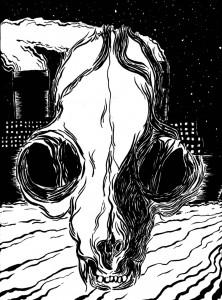
The following is part of SmokeLong‘s series Five from the Archive, which fulfills a need for teaching resources in the flash-narrative community and beyond. In this installment, April Bradley takes a look at five stories covering long period of time in the SmokeLong story archive. Check out the category Flash in the Classroom on the SmokeLong blog for more ideas for teaching flash narratives in your creative writing classroom.
___________________________
by April Bradley
Time is story. Time is the fluid sensory element that shapes narrative. Writers of flash that contend with long periods of time turn to a number of techniques to evoke expansive experiences within compressed narratives. It is tempting to claim that we cannot write flash without expressing time, that such a narrative would be poetry. If any genre is up to the task of this challenge, it is flash. Let’s look at five examples from the SmokeLong Quarterly archives that demonstrate innovative skill with long periods of time, each ranging in word count from 835 to 976 words, towards the higher end of SmokeLong Quarterly’s word limit.
“A Case for De-Extinction at the End of the World” by Lyndsie Manusos
Spanning decades in human reckoning and ages and eons on a geologic scale, Manusos gives us a story about a precocious geneticist who realizes a magnificent achievement as the world hurls towards irredeemable destruction. The nesting time scales—human within the geologic age, within the geologic epoch, within eras, and so on—give this story of grief and resurrection an undeniable sense of extended time compressed.
Writing Prompt: Employ time scales and standards (geological, sidereal, solar, nuclear, human, Planck, rhythm) to illustrate the passage of time.
 “From the Diary of Your Unlived Life” by Andrew Ridker
“From the Diary of Your Unlived Life” by Andrew Ridker
This story chronicles a lifetime of regret with illustrated non-chronological entries in the second person, each a meditation on “If only…” A fascinating aspect of Ridker’s flash is that it depicts a mind feeding the aggrieved scenario after scenario in an attempt to solve the unsolvable. The infinite narrative ends for the reader at the causal event of the main character’s anguish.
Writing Prompt: Write a list of three events; select one, then write ten “If only…” statements with actions that would slightly change the event’s outcome. Write a story about these outcomes.
 “Sweet-N-Low” by Pingmei Lan
“Sweet-N-Low” by Pingmei Lan
A familiar way writers move a narrative through time is by reordering chronological events with analepsis and prolepsis. Flash typically doesn’t leave much room for flashbacks and flashforwards, but this example shows how to masterfully use the techniques. In this layered and complex flash told in the second person, we meet Jian, a young woman exhausted by surviving, when she begins another job and relives her sexual assault by her first employer. Time elides in this flash so that eight years occurs in a moment.
Writing Prompt: Move a character through time by using analepsis and prolepsis: reorder the chronological sequence of at least two events, call the reader’s attention to similar settings, objects, mood, and tone.
“A Thousand Perfect Strangers” by Kathy Fish
This speculative flash occurs over months and even years from multiple perspectives, including the collective second-person plural of connected neural nets and the close third-person perspective of RandallBrownOne, the self-aware, prototype android who grows to love Research Assistant Gem. Fish creates effect by focusing on RandallBrownOne’s evolving feelings and uses time markers like “yesterday” and “then arrives the day,” but it is in world-building and setting—the way time moves around objects—that readers gain a sense of time’s long passage.
Writing Prompt: Write a speculative flash that focuses on emotion-driven effect that also moves through an extended time period using time markers to identify its passage.
“Transplanting” by Lisa Smithies
This narrative takes the reader on an epic, metafictive journey spanning centuries and continents through the perspective of a grass seed, telling the story of its immigration to and colonization of the Australian continent. This is a grand swath of a tiny story, a cinematic gesture contained in the details and fates of the eleven animal and human characters the seed encounters in addition to millions of people, blades of grass, and sheep.
Writing Prompt: Write a story that spans a century or more in fewer than 1,000 words.
Additional SmokeLong Quarterly Long Periods of Time Flash
http://www.smokelong.com/a-short-history-of-those-who-came-before-us/
http://www.smokelong.com/old-man-falling-off-of-stool/
http://www.smokelong.com/wolf-cry/
http://www.smokelong.com/sleepers/
_____________________________________
 April Bradley is a Durham, North Carolina-based writer of short-form fiction and creative nonfiction. Her work has been twice nominated for the Pushcart Prize as well as for The Best of Small Fictions and the Best of the Net Anthologies. Her writing appears in CHEAP POP, Hypertrophic Literary, Journal of Compressed Creative Arts, Narratively, NANO Fiction, SmokeLong Quarterly, and Thrice Fiction, among others. She earned a MAR in Ethics from Yale University and is an MFA student at Sewanee. Her research and writing interests focus on experimental and hybrid narrative forms that explore trauma recovery, memory, mothering, and grief. She serves as a submissions editor at both SmokeLong Quarterly and Pidgeonholes.
April Bradley is a Durham, North Carolina-based writer of short-form fiction and creative nonfiction. Her work has been twice nominated for the Pushcart Prize as well as for The Best of Small Fictions and the Best of the Net Anthologies. Her writing appears in CHEAP POP, Hypertrophic Literary, Journal of Compressed Creative Arts, Narratively, NANO Fiction, SmokeLong Quarterly, and Thrice Fiction, among others. She earned a MAR in Ethics from Yale University and is an MFA student at Sewanee. Her research and writing interests focus on experimental and hybrid narrative forms that explore trauma recovery, memory, mothering, and grief. She serves as a submissions editor at both SmokeLong Quarterly and Pidgeonholes.




 A SmokeLong Summer 24!
A SmokeLong Summer 24!